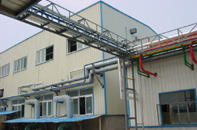
Potassium Monopersulfate for Microetching and cleaning of printed wiring/circuit board (PWB)
Potassium monopersulfate compound (Synonyms: potassium peroxymonosulfate)
is a free-flowing, white granular solid, soluble in water. It is present
as a component of a triple salt including potassium monopersulfate, potassium
bisulfateand potassium sulfate with the formula 2KHSO5·KHSO4·K2SO4
Potassium monopersulfate (KMPS) provides more efficient oxidation
of copper due to its unique chemical structure. It gives better etched
copper surface morphology with uniform distribution of well- defined grain
structure compared to not-in-kind competitive products such as hydrogen
peroxide/sulfuric acid (peroxide) and sodium persulfate (SPS).
Potassium monopersulfate provides heterolytic kinetics that follow a
simple two electron exchange. This simple reaction mechanism offers advantage
over hydrogen peroxide and sodium persulfate in which the peroxide linkage
can be catalyzed by dissolved copper to split in homolytic fashion
forming free radicals. Free radical reactions have much more inconstant
rates of reaction that result in a changing or less predictable etch rate
over the bath life.
 HSO5−
+ 2 H+ + 2 e− → HSO4− + H2O
HSO5−
+ 2 H+ + 2 e− → HSO4− + H2O
E° = 1.85V
- Sulfur, S = 6 valance electrons
- Oxygen, O = 6 valance electrons
- Hydrogen, H = 1 valance electron
Cu° + 2 H+ + HSO5− → Cu2+ + HSO4− + H2O
1) O + 2 e− → O2-
2) O2- + 2H+ → H2O
- Two electron exchange with no free radicals generated
Potassium Monopersulfate provides a superior copper topography when used as microetchant and cleaner in printed wiring board manufacture. The topography is characterized by a roughened metallurgical surface, thereby providing a sufficient number of keying sites to ensure good adhesion for plating and resist lamination. The pH of the KHSO5 can be lowered and surface texture can be varied by the addition of a mineral acid to the solution. Phosphoric acid produces a relatively smoother topography whereas sulfuric acid increases roughness. Typically, about 1 - 5 percent mineral acid by volume of KHSO5 solution is used. KHSO5 is also effective at lower temperatures than other microetchants. For example, KHSO5 is effective at about 24° - 32°C whereas hydrogen peroxide/sulfuric acid solutions require temperatures of about 46° - 54°C. The copper or copper alloy clad substrates subjected to microetching comprise any plies of plastic, fiber glass or other material to which copper foil is adhered or upon which copper is deposited, electrolessly or electrolytically. The substrates can be single or multiple plies in the form of composite or layered structures such as laminates and other materials. Such copper clad substrates and laminates are conventional in the printed wiring board art. The substrates may contain through- holes on the walls of which copper has been deposited for electrical connection. Single laminates or multilayer boards must be microetched and cleaned, usually numerous times during printed wiring board fabrication. Application of the microetching and cleaning solution is usually by spraying or immersion of copper clad substrates in a bath formed with the etching solution, and the solution can be applied in any other convenient manner.
